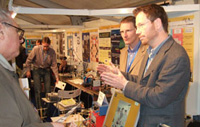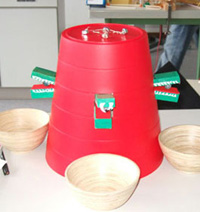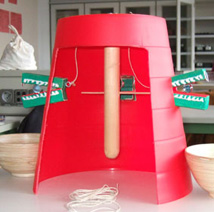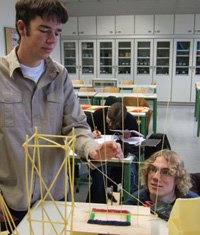Tracing earthquakes: seismology in the classroom Teach article
Chinese dragons that predict earthquakes? Waves of glowing jelly babies? Earthquake-proof spaghetti? Physics teachers Tobias Kirschbaum and Ulrich Janzen explain how they teach geophysics.

Wave diffraction and energy transport are standard components of physics courses for 16- to 19-year-olds across Europe. Usually, students have to prove their knowledge in examinations which concentrate on the exploration of springs, Slinkies® or other classical mechanical devices.
Recent didactical research, however, stresses the importance of integrating scientific theories and models into contexts to which the students can relate. No one will have been left unaffected by the destruction caused by Hurricane Katrina in the USA or the recent earthquakes in Iran, for example.
Simplifying and explaining a concept to younger pupils is a powerful way for older students to make sure that they have thoroughly understood the topic. Developing effective demonstrations, as well as actually teaching younger pupils, fosters the multiple intelligences which proponent Howard Gardner describes as inherent to all groups of students.
The basics of seismology can be integrated into normal coursework. The experiments we describe, however, are also well suited for presenting natural sciences and their importance to a wider public – for example at school open days. And of course, the presentation skills developed by the students can be important later in life.
So much for our reasoning, as we planned a physics course with our older students. At this point, however, the creativity and enthusiasm of the students took over.
The students used web resources, newspaper reports and their textbook, but above all, they soon started to develop their own ideas of what is central and essential to seismology. They began to create model experiments, starting with coupled pendulums and culminating in an attempt to model a tsunami. Three topics proved particularly rewarding: an ancient Chinese seismograph, a simple wave machine and an investigation of earthquake-proof buildings.

Reconstructing an ancient Chinese seismograph
Reports exist of an ancient Chinese seismograph, built some thousand years ago and supposedly of incredible sensitivity. As descriptions survive only of the external appearance, nobody knows how the seismograph was constructed inside. Even though there are books which offer some ideas, nobody – to our knowledge – has ever managed to reconstruct a working model of the original seismograph.
In the seismograph, eight dragons arranged around a bell-shaped metal form held little pearls in their mouths. When an earthquake occurred, the dragon pointing in the direction of the epicentre would drop its pearl into a bowl below. Earthquakes were reputedly registered from hundreds of kilometres away – solely on the evidence of the pearl lying in the bowl.

a Chinese seismograph
reconstructed from a dustbin
After studying images on the worldwide web and in old reports, the students quickly deduced that inertia could be used to open the dragons’ mouths. The students’ dragons were made of two little wooden blocks connected by tape and – not essential to the function – painted to resemble dragons. A spiked pendulum provided a central mass to trigger the dragons, marbles replaced pearls and an upside-down plastic dustbin served as an outer frame of the seismograph.
The main purpose of the model had been to offer a possible explanation of how the ancient Chinese seismograph worked, but the results exceeded all our expectations. Not only did even light blows to the side of the table on which the seismograph was placed cause the dragons to release their marbles, but the direction of the blow was reflected in which dragon dropped its marble. Improvements, such as using a larger mass, preventing lateral movement of the dragon heads, and constructing stiff connections between the pendulum and the dragon heads, should increase the accuracy even further.
A simple wave machine

fantastic wave machine
Most wave machines are made from wood and metal spikes, but they tend to be fragile or too small for classroom display. Instead, some of our students came up with the idea of using wide bands of rubber, used in the waistbands of skirts or trousers and cheaply available. Four old bicycle wheels were donated by a local bike shop and the spokes served perfectly as arms to indicate the wave movements. The spokes were pushed through the rubber band several times and fixed with hot glue. In total, the homemade wave machine was about four metres long.
When stretched across the length of the classroom, the rubber band can be used to demonstrate all important wave phenomena: travelling waves (both transverse and longitudinal), wave reflection and standing waves. For the final presentation on the school’s open day, jelly babies were attached to the ends of the spokes. In black light, the waves glowed mysteriously – not necessary for physics, but definitely an impressive sight.
Investigating earthquake-proof buildings

with standing waves
When searching for information on earthquake-proof buildings, our students quickly came across the Salters Horners Advanced Physics (SHAP) project of the York University Education Group. To test different building constructions, the SHAP authors suggest an earthquake table built from wood, stiff foam and an oscillator. We also used another of the SHAP team’s ideas, presented at Physics on Stage 3 in 2003: instead of constructing buildings from straws or metal kits, Liz Swinbank and her UK team tested buildings made from spaghetti. This was not only effective, but impressive to watch.
Our students were intrigued by this crazy but highly effective choice of material and started modelling different designs of earthquake-safe buildings which they learned about on the worldwide web. They also focused on ways to show the factors that influence the formation of standing waves inside the buildings. The earthquake table with its different models drew crowds at our school’s open day.
Looking back
Though it took some time to develop and produce the demonstrations, the motivational potential of this approach cannot be exaggerated. The students spent hours after school improving their models and testing yet further variations. All members of the course were able to contribute to the success of the project, irrespective of their abilities. This alone made the effort worthwhile, as the experience of a successful project not only helped to strengthen the group, but also enhanced their motivation and interest in other aspects of physics. And of course, the students’ understanding of waves and the underlying physics improved enormously.
References
- Science Education Group, University of York (2001) Salters Horners Advanced Physics: A2 Student Book. Oxford, UK: Heinemann
Resources
- Physics on Stage was the forerunner of Science on Stage, an international teaching festival organised by the EIROforum. See ‘Space balloons, mousetraps and earthquakes: it’s Science on Stage!‘ and ‘Science teachers take centre stage‘ in this issue of Science in School.
- A useful web resource on wave propagation, Seismic Waves, can be downloaded free of charge here.





